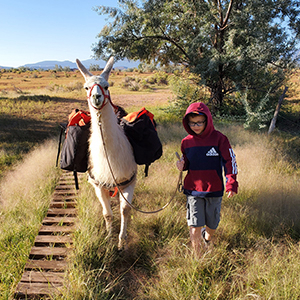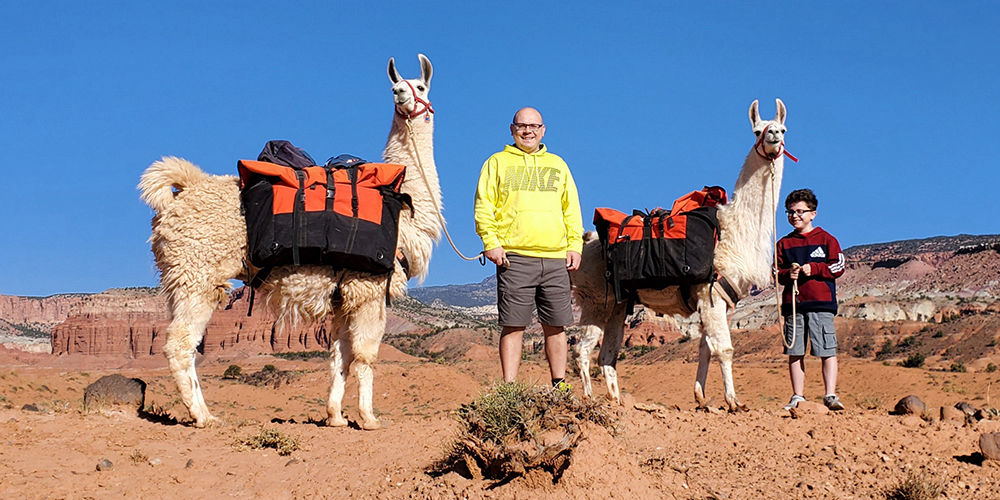n a trip to Capitol Reef National Park with my son, I wanted to try something different, something exciting, something I’d never done before.
So we went on a two-hour llama hike.
When Andrew, the guide, arrived with the 350-pound animals, the first thing I thought was how we were supposed to trust these animals not to trample us. But Andrew explained how to walk the llamas and we began our hike.
Right away, I noticed that my son’s llama was more responsive and much calmer than mine. My llama was less experienced. He was making sounds and being obnoxious. He wasn't responding to me. Andrew took over and taught me to be a little more forceful. He told me to adjust to my llama’s personality. 
As we continued to walk, my son’s llama suddenly became distraught and began making a scary sound. The llama was trying to warn us that there were cows around. But even though the llama was worried, at no point was my son in danger. No matter how upset the llama was, he was following my nine-year-old, who was so much smaller than the llama.
And that’s when I began to wonder, how do you train these big animals to be so reliable? How does everyone—according to the llama outfitter’s Google reviews—have such a great experience? Given my background as a senior value engineer, I made the obvious leap: Could what they do to train these llamas help us provide a better, more reliable patient experience?
After we got home, I called the owner of Wilderness Ridge Llamas to learn how the llamas were trained. The boss told me: If you can’t do it right, don’t do it at all. If you can’t spend all the time training, it won’t be worth it.
These were the key principles they used to train the llamas. And while humans may be a long way from llamas in the phylogenetic tree, the principles might work for us, too. Whether llamas or people, you get a reliable experience by training right:
- Be consistent and persistent with the training.
- Adapt the training to the age and experience.
- Start early and train every day.
- Teach one small concept a day.
- Set milestones and expectations.
- Re-teach every year to break down new habits.
- Set them up for success.
Apply these principles to your learners:
#1 Know your learner
Every person—and every llama—is different. My llama needed a firmer hand than my son’s. When they train the llamas, they take that into account. They train baby llamas differently than older llamas. They provide a different level of attention and set lower expectations.
We can apply that to people, too. Not everyone has the same knowledge or the same skill set. That’s why I like to find out who’s going to be in a class I am teaching. We need to understand people’s backgrounds and where they are coming from so we can present material in the appropriate way. Is the audience medical students or physicians? Does the audience have a clinical background or are they non-clinical? All of these factors matter when teaching a class.
Whether your learners are baby llamas or adult llamas, you can invest energy in examples and training types that are right for them. Everyone will get more out of the experience.
#2 Learning is continuous
The llamas aren’t hiking all the time, every day. They don’t do tours in the off-season. So every year, they have to retrain to break down bad habits they’ve developed when they aren’t hanging out with humans every day. The trainers don’t expect llamas to learn it once and remember it forever.
We shouldn’t expect that from humans either. Learning is continuous. While right after training, everyone may be very aware of what they are doing and very careful to do it correctly, as time passes we become more comfortable. We might forget what we’ve learned. New challenges may change what we do.
That’s why we need to train continuously and retrain when something changes or a lot of time has passed. Everyone needs a refresher now and then to deliver a reliable experience.
#3 Set up for success
They set up every llama for a great, successful hike. If a llama isn’t good with kids, they don’t pair that llama with a kid. In the case of my hike, they gave my son a more experienced, no-drama llama, but gave me a llama with less experience. But we both had a great time and so did the llamas.
When we are training people, we need to set them up for success, too. We need to ensure we aren’t asking too much. To get great, reliable performance, we need to ensure everyone can get the positive recognition that comes with success. When someone succeeds they feel good about work. But if you set them up to fail, if they aren’t prepared, the experience can be traumatic. No one can work well or be reliable in those circumstances.
Obviously, doctors, nurses and administrators are much different than llamas. But the concept of training is the same whether you are hiking at Capitol Reef or delivering patient care on the Wasatch Front. With consistent learning targeted to the right audience, we can help everyone succeed at delivering a reliable experience to our patients.
*Originally published November 2020
Luca Boi
Trust. That’s what we want. We want to earn and keep the trust of every patient. We want them to trust that we provide the best possible medical care. But more than that, we want them to trust that we will respond to their needs, coordinate our efforts, and provide them with available options. We want them to trust that we will answer our phones, explain their treatment, and value their time. The exceptional patient experience is an enterprise-wide system designed to deliver a singular output: trust. And, this enterprise-wide system is built on trusting our providers and our teams.
Navigating budgets and finance can be a daily responsibility for managers, which is not always an easy task. Finance experts Casey Moore and Robert Dickson share the importance of and best practices for Management Reporting and how it can help you become a better leader.
Step into the shoes of James Mwizerwa, environmental services supervisor, to learn how he and his team stay resilient and persevere through their demanding work.
